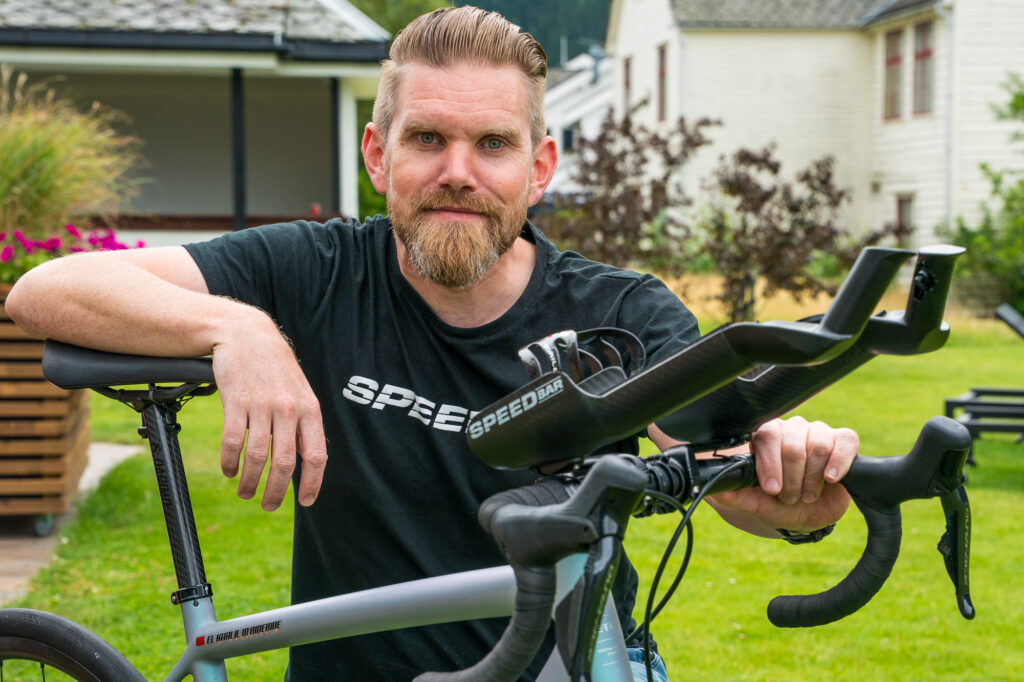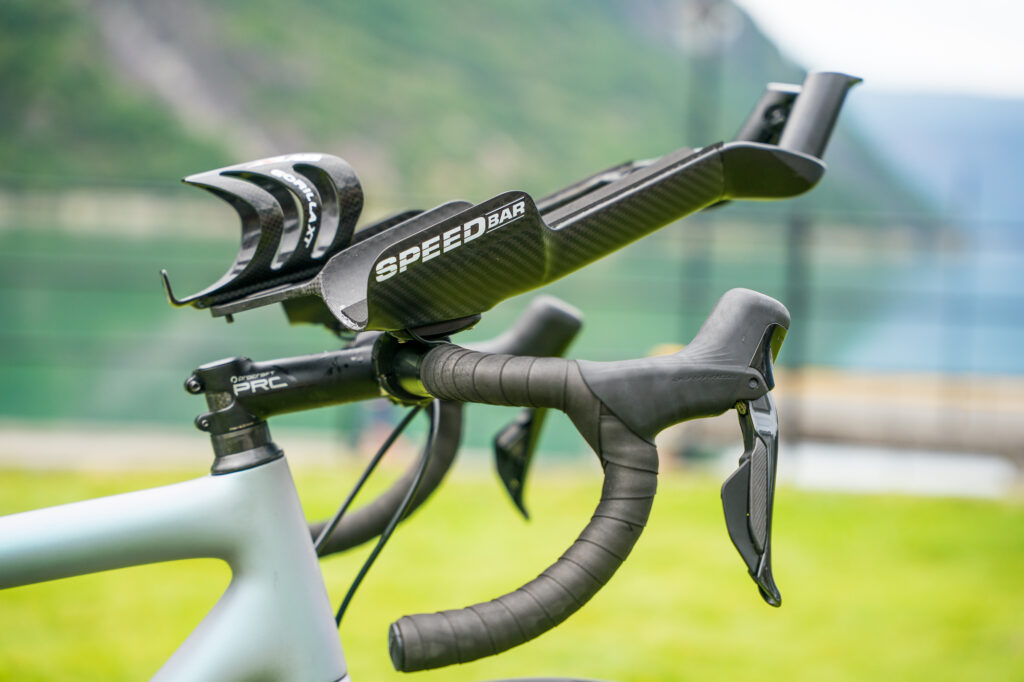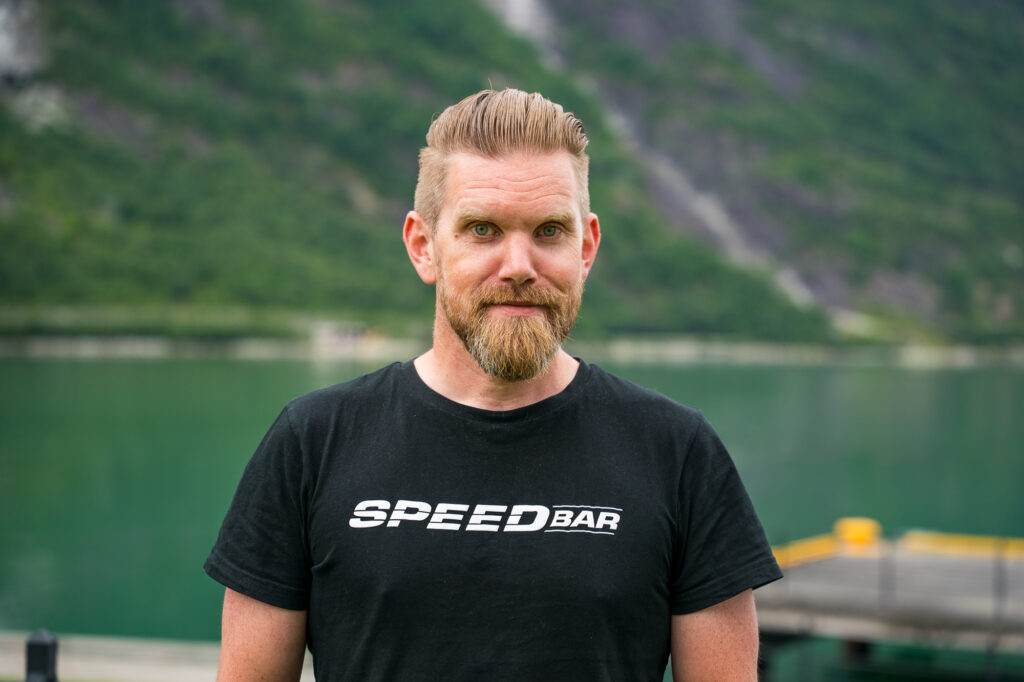From Drainpipes to World Titles: How Speedbar Became the Top TT Bar in Cycling

“Mr. Speedbar” himself — founder Edwin van Vugt. Photos by Kevin Mackinnon
If you have a triathlon bike, go take a look at the aero bars. There are a lot of pieces to them, right? Bolts, clamps, spacers and more. You might see this as a perfect design, with each component carefully placed to make the best bars possible, but Edwin van Vugt sees a problem — maybe just potential problems, but a lot of them. Van Vugt says most TT bikes will have 14 to 16 bolts in the aero bar setup, and all of these pieces are where the problem lies.
“It’s 16 times an opportunity for something to go wrong,” he says. “Fourteen to 16 bolts that can be overtightened, that can rattle loose, that can be corroded with all the sweat.”
So, van Vugt came up with a solution: create a bar that is just one piece. Almost a decade later, his company, Speedbar, is the industry leader in cycling, and he is now turning his attention to triathlon.
Speedbar Origins
Before Speedbar, van Vugt and his wife, Barbara, ran a carbon fibre repair company, adjusting and fixing wheels and bike frames daily. Van Vugt’s expertise in this field garnered him attention from professional cyclists, and he would often be hired to repair and improve the bikes of some of the world’s top riders.
“That’s how I first got in contact with most of the teams,” he says.
Van Vugt started entertaining the idea for Speedbar after the 2016 Olympics in Rio, where Australia’s Rohan Dennis broke his aero bars during the time trial event. Dennis had been in medal position up to that point, but the mishap led to him needing to switch bikes — a moved that ultimately dropped him to fifth place.

One of van Vugt’s many connections in the world of pro cycling was Dennis’s mechanic. The pair started discussing the possibility of a single-piece TT bar that would help cyclists avoid (or at least lower the possibility of) future incidents like the one in Rio.
“TT bikes only come in three or maybe four sizes, depending on the brand, so to come to a good position, you need some adjustability,” van Vugt says. “The adjustability is created with the system — with all the bolts, all the clamps, all the spacers.”
Van Vugt decided to “get rid of all these connections” and, when he did, he saw that this new design came with multiple benefits for riders.
“We found out that, because it’s just one piece, it’s lighter — you don’t have all the connections — and it’s more stiff — you don’t have all the connections,” he says. He also made the bar’s arm-bed “as long as possible” to give the rider more support.
“I used a drain pipe as a mold to create a longer arm-bed, and it extended all the way to where his wrist was bending,” van Vugt says. With the prototype developed, next came the testing. Van Vugt went to Spain, where Dennis and his BMC teammates were training. It was a windy winter day, but that didn’t affect Dennis and his brand-new aero bars.
“He was actually the only rider of the team who could maintain his aero position,” van Vugt says. “This was like the lightbulb moment that we’d created something that was lighter, stiffer and gave him more control over the bike at the same time.”
That was the birth of Speedbar, and it didn’t take long for the rest of the cycling world to buy in.
Starting At the Top
It is not lost on van Vugt just how unique it is to start a business or launch a product with someone of Dennis’s status. When Dennis first tested those aero bars in Spain, he was the current world champion.
“Normally, when you start out a new business or a new plan, you start from the bottom and you work your way up,” van Vugt says. “We started at the top.”
One might think that starting at the top left Speedbar nowhere to go but down, but that was not the case. Belgian cyclist Victor Campenaerts heard about the new aero bars Dennis was using and wanted to try them for himself.
“He had a plan in mind to do an hour record attempt,” van Vugt says. “He contacted me and said, ‘I saw your project with Rohan. Could we do something similar with my track bike?'”
Van Vugt said yes, and in April 2019, Campenaerts rode 34.2 miles in an hour, breaking the world record using Speedbar aero bars.
It was his work with Campenaerts that really put Speedbar on the map. The hour record attempt was broadcast on Eurosport, van Vugt says, so everyone saw Campenaerts’s new and unique aero setup for that ride.
“Cycling is a very simple sport: the winner is always right,” van Vugt says. “He was using something new, he broke the record … and from there, it sky-rocketed.”
Since then, Speedbar has worked with Tour de France, Giro d’Italia and Vuelta a España winners, European cycling champions, world champions and Olympic gold medallists. With all of these accolades under his belt, someone told van Vugt that he had “done it all” in cycling.
“‘You’ve finished the game,'” van Vugt recalls them telling him. “‘You have the yellow jersey, you have the pink jersey, you have the red jersey, you have the rainbow jersey.'”
With one “game” complete, he decided to move to another.
“Now it’s the time to concentrate on triathlon,” he says.
Speedbar Takes Triathlon
If something works in cycling, triathletes are bound to use it, too, so it didn’t take too long for Speedbar to make an impact in the world of multi-sport racing.
“We’ve been on the podium in Kona, we’ve been on the podium winning T100 races,” van Vugt says. “Challenge Roth was won with Speedbar. So, yes, we’re quite a way [into it]. But the market in triathlon is way bigger than it is in cycling.”

Van Vugt poses in Eidfjord, Norway, where he was supporting a Speedbar customer at the Norseman Xtreme Triathlon.
The process of customizing aero bars for triathletes is also very different for van Vugt compared to when he does it for cyclists. For time trial specialists, comfort is, of course, important to a certain degree, but the cyclists will not be in their aero position for nearly as long as some triathletes, nor will they need to be fresh when they get off the bike.
“[For triathletes], it’s always about finding a balance between getting as aerodynamic as possible, but also being able to do the running afterwards,” van Vugt says.
So many of the triathletes van Vugt has worked with will ask him some version of the same question, and it’s always about wattage.
“The first question I’m asked is, ‘If I go for a Speedbar, how many watts will I save?'” he says. “The bar itself doesn’t make you faster. The bar isn’t more aerodynamic. The main benefit is that it take a lot less energy to maintain your position. The energy you save with it can be used for the running.”
Some people think all they need to do is put a Speedbar on their bike with their regular setup and they’ll immediately be faster, but van Vugt says that’s not the case. Instead, he takes athletes through a serious testing process to help find the optimal position and setup for them.
“The best way to do it is to combine it with an aero test,” he says, noting that this can be on the track or in a wind tunnel. “The bar can be whatever you wish it to be, so in terms of stack, reach, angle, position, length, the shape of the grips, the shifter location. Everything is customizable. It would be a shame to only take the measurements from your current setup and say, ‘Well, this is what I like right now, so this is how my bars should be on the bike.'”
In these tests, van Vugt will have the athlete ride a number of reps at a specific speed. He will watch the power output, and if the athlete is holding the prescribed pace while pushing lower power, the better the position.
“There’s a little bit more calculations and science behind it, but that’s the basics of it,” he says. The power output will be different for every athlete, and it’s not the focus of what van Vugt is testing.
“So, when the question is how many watts you’ll save…” he says, trailing off. He tosses his hands up in a shrug. “I don’t have a clue. It’s not about saving the watts, it’s about saving the energy in the end.”
The Speedbar process is much longer than anything you’ll find with other aero bars. It used to be longer (van Vugt would design the bars on his own, and a single set took him 20 hours), but 3D printing has allowed him to quicken production. It’s the testing that is the most time-consuming, but that is what makes Speedbar unique, as it is entirely customized. That’s also what makes these bars so pricey, as they come in at €3,000 (about US$3,500). Van Vugt recognizes that this is not a cheap option for age groupers, but he stands by the cost.
“In my opinion, if you choose a brand like this, it’s because you want to go all the way,” he says. “Speed is for sale. We sell it.”




Great interview!
Edwin’s new ultra lightweight bars are sooooo light. Have to hold to be wowed.
Have set up Rudy, Trevor, Morgan and Holly this year on these bars and Edwin has been great to work with.